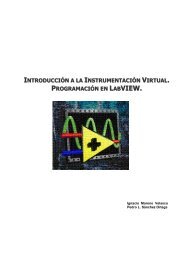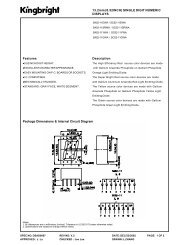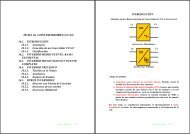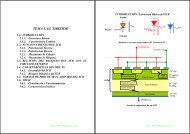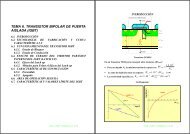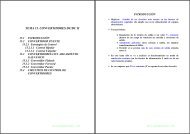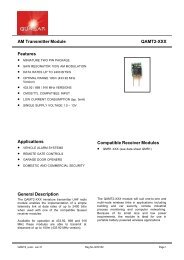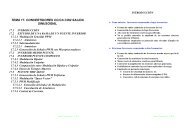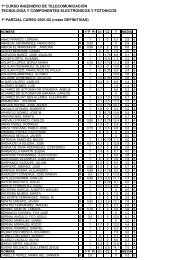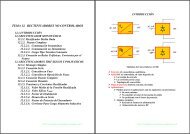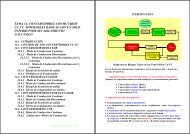AD8307 Low Cost DCâ500 MHz, 92 dB Logarithmic Amplifier Data ...
AD8307 Low Cost DCâ500 MHz, 92 dB Logarithmic Amplifier Data ...
AD8307 Low Cost DCâ500 MHz, 92 dB Logarithmic Amplifier Data ...
You also want an ePaper? Increase the reach of your titles
YUMPU automatically turns print PDFs into web optimized ePapers that Google loves.
<strong>AD8307</strong><br />
APPLICATIONS<br />
The <strong>AD8307</strong> is a highly versatile and easily applied log amp<br />
requiring very few external components. Most applications of<br />
this product can be accommodated using the simple connections<br />
shown in the preceding section. A few examples of more<br />
specialized applications are provided here.<br />
Buffered Output<br />
The output may be buffered, and the slope optionally increased,<br />
using an op amp. If the single-supply capability is to be preserved,<br />
a suitable component is the AD8031. Like the <strong>AD8307</strong>, it is<br />
capable of operating from a 2.7 V supply and features a rail-torail<br />
output capability; it is available in a 5-lead version and in dual<br />
form as the 8-lead AD8032. Figure 18 shows how the slope may<br />
be increased to 50 mV/<strong>dB</strong> (1 V per decade), requiring a 5 V<br />
supply (90 <strong>dB</strong> times 50 mV is a 4.5 V swing). VR1 provides a<br />
±10% slope adjustment; VR2 provides a ±3 <strong>dB</strong> intercept range.<br />
With R2 = 4.99 kΩ, the slope is adjustable to 25 mV/<strong>dB</strong>, allowing<br />
the use of a 2.7 V supply. Setting R2 to 80.6 kΩ, it is raised<br />
to 100 mV/<strong>dB</strong>, providing direct reading in decibels on a digital<br />
voltmeter. Since a 90 <strong>dB</strong> range now corresponds to a 9 V swing,<br />
a supply of at least this amount is needed for the op amp.<br />
INPUT<br />
–75<strong>dB</strong>m TO<br />
+16<strong>dB</strong>m<br />
0.1F<br />
INP VPS ENB INT<br />
<strong>AD8307</strong><br />
INM COM OFS OUT<br />
NC<br />
VR2<br />
50k<br />
32.4k<br />
4.7<br />
3<strong>dB</strong><br />
VR1<br />
50k<br />
R S<br />
AD8031<br />
20mV/<strong>dB</strong><br />
NC = NO CONNECT<br />
C1<br />
V P , 2.7V–5.5V<br />
FOR V P = 3V, R S = 20k<br />
V P = 5V, R S = 51k<br />
R1<br />
20k<br />
OUTPUT<br />
50mV/<strong>dB</strong><br />
10%<br />
R2<br />
30.1k<br />
COM<br />
Figure 18. Log Amp with Buffered Output<br />
C1 is optional; it lowers the corner frequency of the low-pass<br />
output filter. A value of 0.1 µF should be used for applications<br />
in which the output is measured on a voltmeter or other low<br />
speed device. On the other hand, when C1 is omitted, the 10%<br />
to 90% response time is under 200 ns and is typically 300 ns to<br />
99% of final value. To achieve faster response times, it is necessary<br />
to lower the load resistance at the output of the <strong>AD8307</strong>,<br />
then restore the scale using a higher gain in the op amp. Using<br />
8.33 kΩ, the basic slope is 10 mV/<strong>dB</strong>; this can be restored to<br />
25 mV/<strong>dB</strong> using a buffer gain of 2.5. The overall 10% to 90%<br />
response time is under 100 ns. Figure 19 shows how the output<br />
current capability can be augmented to drive a 50 Ω load; R T<br />
optionally provides reverse termination, which halves the slope<br />
to 12.5 mV/<strong>dB</strong>.<br />
Four-Pole Filter<br />
In low frequency applications, for example, audio down to<br />
20 Hz, it is useful to employ the buffer amplifier as a multipole<br />
low-pass filter in order to achieve low output ripple while maintaining<br />
a rapid response time to changes in signal level.<br />
INPUT<br />
–75<strong>dB</strong>m TO<br />
+16<strong>dB</strong>m<br />
0.1F<br />
INP VPS ENB INT<br />
<strong>AD8307</strong><br />
INM COM OFS OUT<br />
NC<br />
VR2<br />
50k<br />
6.34k<br />
4.7<br />
3<strong>dB</strong><br />
R S (SEE FIGURE 36)<br />
10mV/<strong>dB</strong> 18%<br />
VR1<br />
5k<br />
AD8031<br />
NC = NO CONNECT<br />
R1<br />
2k<br />
2N3904<br />
25mV/<strong>dB</strong><br />
R2<br />
3.01k<br />
Figure 19. Cable-Driving Log Amp<br />
V P , 2.7–5.5V<br />
R T<br />
(OPTIONAL)<br />
OUTPUT<br />
50<br />
MIN<br />
COM<br />
In Figure 20, the capacitor values were chosen for operation in<br />
the audio field, providing a corner frequency of 10 Hz, an attenuation<br />
of 80 <strong>dB</strong>/decade above this frequency, and a 1% settling<br />
time of 150 ms (0.1% in 175 ms). The residual ripple is 4 mV<br />
(± 0.02 <strong>dB</strong>) when the input to the <strong>AD8307</strong> is at 20 Hz. This<br />
filter may easily be adapted to other frequencies by proportional<br />
scaling of C5–C7 (e.g., for 100 kHz use 100 pF). Placed ahead<br />
of a digital multimeter, the convenient slope scaling of 100 mV/<strong>dB</strong><br />
requires only a repositioning of the decimal point to read directly in<br />
decibels. The supply voltage for the filter must be large enough<br />
to support the dynamic range; a minimum of 9 V is needed for<br />
most applications; 12 V is recommended.<br />
INPUT<br />
5mV TO<br />
160V rms<br />
C3<br />
2.5nF<br />
R1<br />
50k<br />
C1<br />
10F<br />
0.1F<br />
INP VPS ENB INT<br />
<strong>AD8307</strong><br />
NC<br />
INM COM OFS OUT<br />
C2<br />
10F<br />
4.7<br />
VR1<br />
2k<br />
422<br />
INT 4<strong>dB</strong><br />
C4<br />
1F<br />
V P<br />
C5<br />
1F<br />
34k<br />
VR2<br />
50k<br />
SLOPE C6<br />
32.4k<br />
1F<br />
OP AMP IS AD8032<br />
SCALE C1–C8 AS NEEDED<br />
(SEE TEXT). NOTE POLARITIES<br />
IF TANTALUM CAPACITORS<br />
ARE USED.<br />
7.32k<br />
100k<br />
34k<br />
80.6k<br />
C8<br />
1F<br />
C7<br />
1F<br />
OUTPUT<br />
100mV/<strong>dB</strong><br />
75k<br />
93k<br />
COM<br />
Figure 20. Log Amp with Four-Pole <strong>Low</strong>-Pass Filter<br />
Figure 20 also shows the use of an input attenuator that may<br />
optionally be employed here, or in any other of these applications,<br />
to produce a useful wide-range ac voltmeter with direct-decibel<br />
scaling. The basic range of –73 <strong>dB</strong>m to +17 <strong>dB</strong>m (that is, 50 µV<br />
rms to 1.6 V rms, for sine excitations) is shifted for illustrative<br />
purposes to 5 mV to 160 V rms (at which point the power in R1<br />
is 512 mW). Because the basic input resistance of the <strong>AD8307</strong><br />
is not precise, VR1 is used to center the signal range at its input,<br />
doubling as a ±4 <strong>dB</strong> intercept adjustment. The low frequency<br />
response extends to 15 Hz; a higher corner frequency can be selected<br />
as needed by scaling C1 and C2. The shunt capacitor C3 is<br />
used to lower the high frequency bandwidth to about 100 kHz, and<br />
thus lower the susceptibility to spurious signals. Other values<br />
should be chosen as needed for the coupling and filter capacitors.<br />
REV. B<br />
–15–



